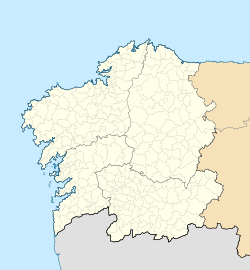Santiago de Compostela | |
|---|---|
|
| |
 Location of Santiago de Compostela | |
| Coordinates: 42°52′40″N 8°32′40″W / 42.87778°N 8.54444°W | |
| Country | Spain |
| Autonomous Community | Galicia |
| Province | A Coruña |
| Parishes | 30
|
| Government | |
| • Type | Mayor–council |
| • Body | Council of Santiago |
| • Mayor | Goretti Sanmartín (BNG) |
| Area | |
| 220 km2 (80 sq mi) | |
| Elevation | 260 m (850 ft) |
| Population (2020)[1] | |
| 97,849 | |
| • Density | 440/km2 (1,200/sq mi) |
| • Metro | 183,855 |
| Demonyms | |
| Time zone | CET (GMT +1) |
| • Summer (DST) | CEST (GMT +2) |
| Area code | +34 |
| Website | santiagodecompostela |
Santiago de Compostela,[a] simply Santiago, or Compostela,[3] in the province of A Coruña, is the capital of the autonomous community of Galicia, in northwestern Spain. The city has its origin in the shrine of Saint James the Great, now the Cathedral of Santiago de Compostela, as the destination of the Way of St. James, a leading Catholic pilgrimage route since the 9th century.[4] In 1985, the city's Old Town was designated a UNESCO World Heritage Site.
Santiago de Compostela has a very mild climate for its latitude with heavy winter rainfall courtesy of its relative proximity to the prevailing winds from Atlantic low-pressure systems.
- ^ Municipal Register of Spain 2018. National Statistics Institute.
- ^ "Santiago". Dictionary.com Unabridged (Online). n.d.
- ^ Lopez Alsina, Fernando (2013). La ciudad de Santiago de Compostela en la Alta Edad Media (2. corr ed.). Santiago de Compostela: Consorcio de Santiago. ISBN 9788415876694.
- ^ Encyclopaedia Britannica (1823), p. 500.
Cite error: There are <ref group=lower-alpha> tags or {{efn}} templates on this page, but the references will not show without a {{reflist|group=lower-alpha}} template or {{notelist}} template (see the help page).








